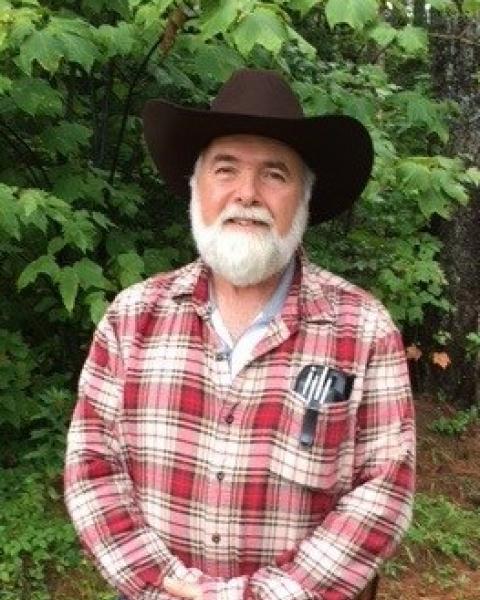Agroforestry
We are now well into October and our fall colors are rapidly fading and falling. Seems like the colors were pretty and quite vibrant but lasted only a very short time. I sincerely hope you all had the opportunity to get out and enjoy before they leave us. This month I want to talk a little about a somewhat different management technique. The term Agroforestry has been around for perhaps centuries, certainly decades across most of our country, but is fairly new here in northern New England. Defined, Agroforestry is the intentional integration of trees and shrubs into crop and animal farming systems to create environmental, economic, and social benefits. According to the USDA Agroforestry Strategic Framework, for a management practice to be called agroforestry, it typically must satisfy the four “I”’s: • Intentional • Intensive • Integrated • Interactive There are essentially three types of Agroforestry Farming Systems. Alley cropping: planting crops between rows of trees to provide income while the trees mature; Forest farming: growing food, herbal, botanical, or decorative crops under a forest canopy that is managed to provide ideal shade levels as well as other products; and Silvopasture: combining trees with livestock and forage on one piece of land. The practice that seems to be the most common, or certainly growing in popularity with our farmers, is Silvopasture. This practice, managing for both trees and forage, allows multiple benefits to be realized on your land. If managed properly, Silvopasture (sometimes called ‘forest grazing’) can provide a diverse source of income and enhance the health of the forest. Here in northern New Hampshire, one of the specific advantages to managing for both trees and forage is that trees provide shade and weather protection for livestock. During the warmer months, the forested setting provides a naturally cooler environment keeping them healthier. Streams and ‘wet holes’ provide cool water sources, much like they do for our natural wildlife.
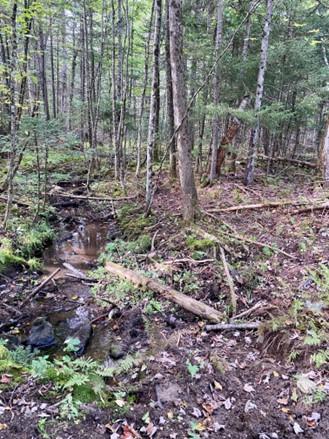
This is looking downstream from a stream crossing location within a current ‘silvopasture’ application. One can make out the trail that has been made along the waterway. This is very similar to the hundreds of miles of wildlife trails along waterways in our natural forested areas across the region.
Combining timber management operations with livestock grazing can also help to decrease competition between different trees and vegetation. This becomes especially true with our softwood stands. After a harvest operation, typically there are deciduous trees that begin to become established, as well as shrubs and other non-woody vegetation. By introducing the grazing application these competing plants are more likely to become part of the food source for the livestock, therefore eliminating, or certainly minimizing, the competition with the desired regenerating softwood.
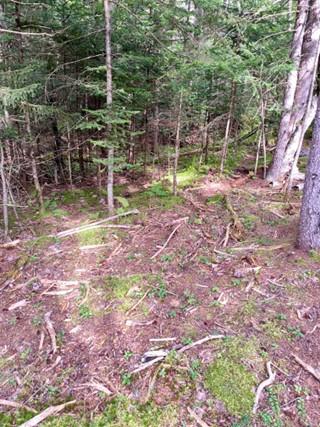
This is an area off the beaten path where you can notice some of the trails that have been forged through the forest. Two things of importance here. First, since they are traveling through a softwood forest, there is no browsing, which therefore maintains the forest composition and condition and eliminates competition. Second, you can notice that the travel from the herd helps to break down the dead material on the forest floor, thus increasing the availability of this material to decay and provide nutrients to the soil.
Adding livestock grazing to typical forest management activities also helps to maintain skid trail condition. Frequently, once a timber harvest has been completed, skid trails are either naturally or manually seeded in with grasses and other herbaceous vegetation. The grazing livestock may keep this growth in check and ‘mowed’ which can facilitate a thicker ‘carpet’ of vegetation, as well as aiding in future access to the area.
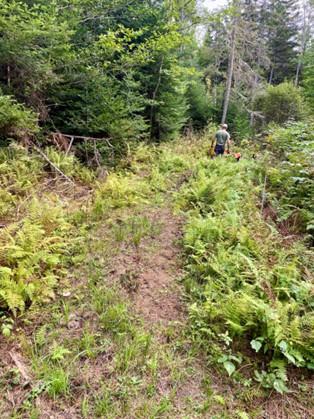
This is a travel route used by the herd that coincides with an historic skid trail used during past timber harvest operations. This use keeps most of the vegetation from getting too tall while maintaining good access into the property.
Although Silvopasture, or forest grazing, has many advantages, there are some risks involved if things are not properly managed. Most of these risks have to do with forest regeneration, specifically within our hardwood forests. Left unchecked, continual grazing may very well eliminate some species of regenerating hardwood trees from the understory, much like over grazing by our native White-tailed Deer and Moose can do. With proper management and practicing ‘rotational grazing’, these adverse effects may be minimized and controlled. The practice of ‘rotational grazing’ or ‘intensive grazing management’, is often done by grazing one pasture at a time, for a specific time period, then moving from that area and onto another. This practice allows each pasture area to rebound and respond to the grazing and introduction of ‘fertilizer’, while providing younger growth for the livestock to feed upon. Including a managed forest area in this rotation provides the livestock with the benefits outlined above, while controlling the time spent, and therefore vegetation grazed upon, in the forested setting. Areas where the desired tree species have seeded in after a harvest may also be fenced off from the grazing livestock to allow these trees to become more established and grow beyond grazing size.
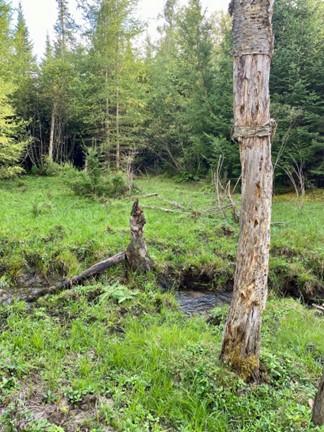
This is an old beaver pond area that has dried up since the original dam broke through, allowing the stream to flow as intended. The herd has been grazing here, which has maintained this open wildlife habitat in an otherwise closed-canopy forest setting.
The thought and practice of combining both timber and livestock management on the same acre is certainly not new in the big picture, even though it is not extremely common here in northern New Hampshire. As our farm and forest landowners continue to manage properties in the most efficient and conscientious manner, the practice of Agroforestry, and Silvopasture specifically, may very well become more prevalent.
For more information contact
-
Your local Natural Resources Conservation Service (NRCS): The NRCS provides technical assistance and financial support to landowners who wish to implement conservation practices on their land.
- UNH Cooperative Extension: The Agriculture and Forestry Field Specialists in each of our counties, as well as our State Specialists, will be able to assist with information and resources to help with your management goals.
Sources
-
USDA Agroforestry Strategic Framework: Fiscal Year 2019-2024
-
Clason, Terry, and Steven Sharrow. 2005. “Silvopastoral Practices.” Pp. 119-147 in North American agroforestry.

